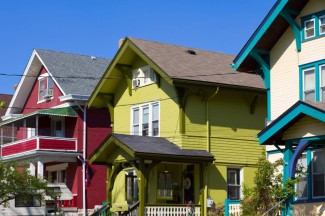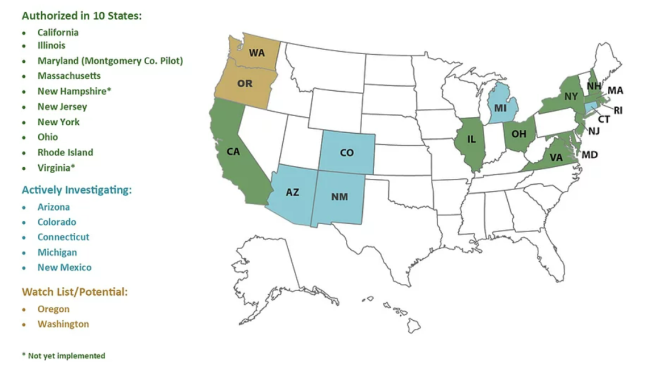Across the United States, more local governments are adopting a utility alternative for providing customers with electricity that boosts use of renewable energy. Yet most taking this option—known as community choice aggregation (CCA)—do not yet pursue energy-saving initiatives that can help meet climate goals, according to the first report ever to assess the role of energy efficiency in CCA.
The ACEEE report, published today, shows community choice aggregators (CCAs) are gaining momentum, with hundreds active in several states and new ones starting this year in Providence and other cities in Rhode Island. Formed by one or more local governments, CCAs give customers an alternative to the local utility. While the utility still transmits electricity, manages billing, and provides other services, often including energy efficiency programs, CCAs procure electricity from alternative sources, such as wind and solar. They generally offer electricity mixes with higher renewable content that is cost competitive with the local utility.
So far, nine states have passed legislation allowing CCAs, and Maryland recently empowered Montgomery County to pursue a pilot program.[1] While many CCAs aim to increase renewables and reduce climate-warming emissions, they can also address equity issues by lowering energy bills for residents struggling to make ends meet. Whether the goal is to reduce emissions, reduce costs, or both, energy efficiency can help.
By surveying CCAs, our report recommends ways they can overcome the regulatory and cost challenges that often stymie them from incorporating energy efficiency.
Source: Lean Energy U.S.
Current Energy Efficiency Approaches
Most CCAs either do not engage in energy efficiency at all or they connect their customers to existing utility-administered programs. However, CCAs have lots of opportunities to leverage energy efficiency. For example, Valley Clean Energy, which serves several cities in California, offers a hub for customers to access energy-saving opportunities available to them through utilities, tax incentives, and other sources. Some cities offer energy-saving options separate from their CCA. For example, Cincinnati administers WarmUp Cincy, which offers energy assessments, upgrades, education, and bill assistance to low-income residents. While Cincinnati has a CCA, the CCA is not directly involved in WarmUp Cincy.
We have identified CCAs, though, that administer their own varying energy efficiency initiatives, such as rebates for buying energy-saving appliances. With the exception of Cape Light Compact in Massachusetts, all of these CCAs operate in California.
—In the San Francisco Bay Area, Marin Clean Energy (MCE) offers its customers several opportunities in addition to those provided by the local utility. Such options include its Low-Income Families and Tenants Pilot Program that provides rebates for a variety of energy- and water-saving products, such as furnaces, appliances, water heaters, and windows. Over the lifetime of its energy efficiency programs, MCE has saved its customers $11.7 million.
—In Massachusetts, Cape Light Compact’s energy efficiency services have saved customers more than $100 million since the services began in 2001. Cape Light Compact offers financial incentives for energy-efficient new home construction. Customers also have access to zero-interest loans and rebates for energy efficiency projects, as well as comprehensive energy assessments.
—In Northern California, Redwood Coast Energy Authority has supported energy efficiency in schools and residential and commercial buildings. It has provided expertise and organizational support for 22 school districts implementing energy efficiency measures, such as fuel substitution and improvements to refrigeration, HVAC, and hot water systems. over the past five years. Through its own funds, Redwood Coast provided more than 250 residential energy consultations and 90 residential energy efficiency kits to its customers in 2020 and provided no-cost energy assessments to commercial customers.
Recommendations, Strategies, and Challenges
CCAs may be able to strengthen existing energy efficiency efforts of utilities and governments by targeting hard-to-reach customers and leveraging relationships in their community.
Compared to CCAs, most utilities have greater financial resources and longer histories of offering energy efficiency services. So, if the programs already available to a given CCA‘s customers (via the utility) are strong, effective, and equitable, then the CCA may best serve its customers’ interests by directing them to existing programs.
However, if a CCA finds that existing utility programs are not reaching all customers or are otherwise inadequate, developing its own programming may be advisable. A CCA’s capacity, regulatory context, community needs, and existing local offerings should guide its approach. CCA programs can often help distribute the costs and benefits of energy equitably by understanding the demographics and needs of their communities.
Some CCAs explicitly identify equity as a program goal, and more should do the same. There is room for all CCAs to do more to contribute better societal outcomes and incorporate accountability for equity into their initiatives. As more communities pursue a CCA to reach their climate goals, this report provides a resource on how energy efficiency can play a vital role.
[1] CCAs are currently authorized in nine states: California, Illinois, Massachusetts, New Hampshire, New Jersey, New York, Ohio, Rhode Island, and Virginia





